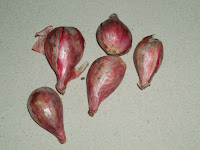Eggplants - Solanum Malongena

Eggplants are low in calories and are an excellent source of dietary fiber. They are also a very good source of potassium and vitamins B1 and B6. Eggplants are also a good source of folic acid, magnesium, coper, manganese, and niacin. Eggplant skins contain an anthocyanin flavonoid called nasunin. It's A potent antioxidant and free-radical scavenger. Studies have shown that nasunin protects cell membranes from damage. Nasunin also helps to move excess iron out of the body. Eggplants may also help to lower cholesterol levels. All fruits and vegetables offer outstanding health benefits. Nutritional research shows that each one contains its own set of vitamins, minerals, antioxidants, and other important nutrients. To get the maximum health benefits, experts recommend eating a variety of fruits and vegetables along with other natural foods.
Labels: Benefits


